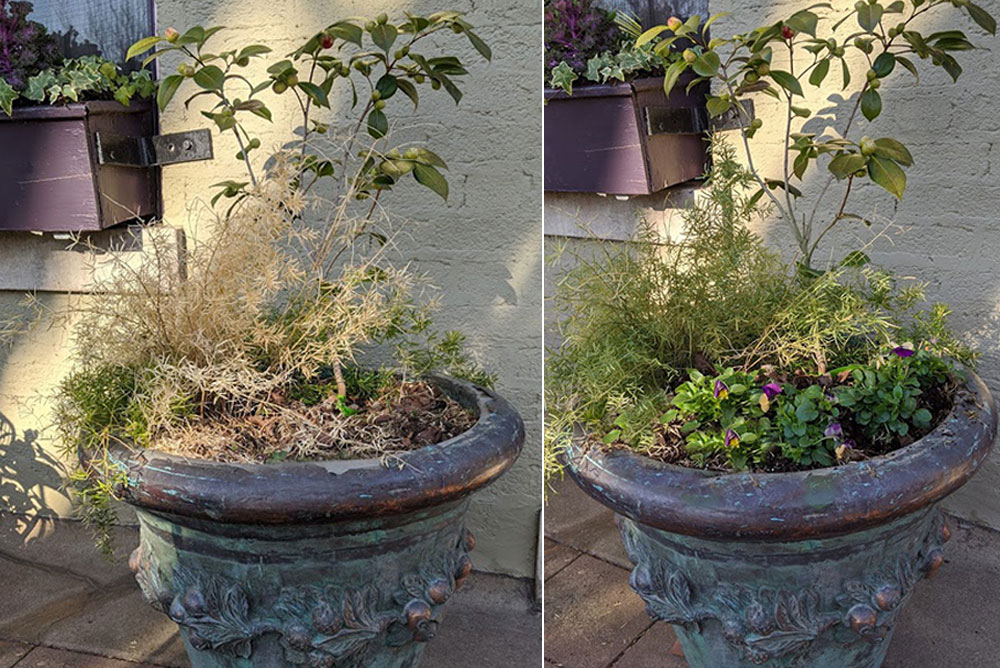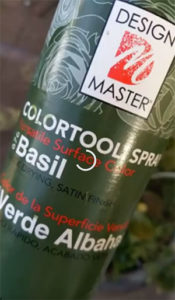
It’s alive! It’s alive! Well, almost, or not really, but spray paint neatly spans the gap. / Photo by Stephanie Cavanaugh.
THE WASHINGTON POST’S Capital Weather Gang just announced that peak bloom for the Tidal Basin cherry blossoms has now been moved back five days to March 22nd—with one tree already fully flush with blossoms. If there’s anything positive to be said for the coronavirus it’s that tourists might stay away and those of us who live in and around Washington DC might get to enjoy the show all by our lonesomes, pretty much a once-in-a-lifetime event—should we live another few weeks.
That said, it’s still too early to spread summer seeds, plant tender plants, and so forth, but some of the hardier house plants would be thrilled at a little fresh air—just keep them close to the house in case you have to snatch them in if a frost threatens.
I am, in fact, about to instruct My Prince to schlep the sago palm out from the foyer, where it perches for the winter in a cast-iron pot, to the front porch, where it summers on a pedestal between the front windows.
I just did.
“Okay. You’re the boss,” he said, then ignored me.
While the winter has been absurdly mild, things are still looking a bit ratty and neglected, making one itchy to do something . . .
A few suggestions from my book of instant garden repairs . . . *

When in doubt, go to Michaels and . . . spray, baby, spray. / Photo by Stephanie Cavanaugh.
In summer, the camellia in the planter beside the front door is nestled in various flowers and greens, most of them pulled for the winter and happily ensconced in the greenhouse waiting for more permanent warmth. I left a plug of asparagus fern —just to see—and miraculously it more or less survived. The “less” part being that half of it was a wheaty-pale frizzle as of last Sunday. This sat alongside what could only be called a patch of dirt, a sight not particularly cheery or welcoming.
I could have cut it back, the frizzle, but I like the frothiness of the fern. This is where spray paint comes in handy, specifically Design Master’s Colortool Spray in a shade called Basil, which has a particularly springy air, pale and fresh and amazingly natural. A spritz here and there and the fern looks entirely revived. A few pansies popped in and it’s a jolly sight—a five-minute fix, just the way I like it. I have no patience, you know.
When I knit, which is rarely, it is always a scarf on extra-large needles using super-bulky yarn. If I can’t do six feet in an evening I lose interest. That is neither here nor there, just illustrative.
Spray paint is great for all sorts of dead- and deadish-looking plants, like boxwood, which you don’t want to replace for a few more weeks. Also astilbe, which has that nice feathery plume that waves at you for a bit then gradually and unpleasantly browns. Pick a color, any color, spray, and you have what appears to be a living flower that lasts until frost. A gloss paint gives them a spritely ceramic look that glints in the sunlight.
You can plant a few things now—those charming flowers of spring: pansies, ranunculus, hardy cyclamen, hyacinth, primrose. All of which are often hardly worth the price or effort in the DC climate, frying as they do when our usual three days of spring is replaced by summer swelter. Planting them this year should be worth it—we might get weeks of pleasure from them. For once.
You could also amuse yourself looking for pots. Cast iron, ceramic, something wonderful. If I had money I’d check out MacKenzie-Childs, since I love their play with black and white, pattern mix, and splashes of color. If I were talented, I’d paint my own pots. Being neither wealthy nor artistic, I watch the curbs, thrift shops and junque shops for the rare.
Speaking of junque shops.
There’s a fine one outside of Culpeper, Virginia, called Slindy’s, which specializes in items like dusty oil paintings on velvet and gently used Swedish military uniforms, but sometimes there’s a real find. One day a few years ago, I picked up a plaster pedestal, about three and a half feet tall, shaped like an ionic column, all fluted sides, you know. I believe it was three bucks.
I carried it to the car trunk and set it down on the concrete parking surface where it immediately cracked into two pieces, top and bottom. There was some fuss about my being too rough with things, which I denied, and we took it home, where I sat and contemplated it for a bit. The two halves didn’t appear useful for anything since each had a base to sit on but a jagged top where nothing would rest easily, and they wouldn’t hold water . . .
And then, a eureka moment. If I stuffed something in the jagged opening of one of them, a beaker perhaps, I could use it as a vase. Which is what I did. A slender plastic water bottle with the top sawed off was the perfect size. One half of the column now sits behind the living room sofa, stuffed with palm fronds or Queen Anne’s lace, so airy in summer even though it tends to shed.
The other half I gave to Baby, who uses it similarly.
The funny part of this story is that, shortly after this find, I came across a similarly broken pedestal at an antiques shop in Georgetown, hung with a fancy parchment tag with $350 handwritten in a scrolling script the color of faded blood. I’d love to know who bought it.
That bottle business, by the way, is a neat way to turn anything into a vase, or put one that leaks back into use. Measure the opening and the depth, head for the grocery store, and you’ll find a jar, a tube, or a bottle of something that fits. With any luck, you’ll enjoy eating or drinking the contents too.
But returning to pots, which was the subject at hand.
I’ve finally given a rhododendron a shot, 35 years late. The large green ceramic pot in the front yard was looking sad, filled as it was with some straggly foliage of Something That Did Not Work. This one, a flashy pink number called Holden, now sits in front of the forsythia, which is blooming splendidly but will fade as Holden’s flowers open. At least I hope so. The idea of pink and yellow together makes my flesh crawl.
We shouldn’t have planted the forsythia in the first place, but I was in a rush (see knitting, above) to have a garden in my new home and they were cheap and big and so forth. And they do screen the front porch from passersby, so I can sit and read and sneak peaks, popping up to scream if they let their pups lift a leg in the wrong spot.
I never said I was nice. Did I.
—Stephanie Cavanaugh
LittleBird “Stephanie Gardens” knows spray paint to be the secret gardening tool.
*Another of the books I haven’t written but mean to, should I live.
MyLittleBird often includes links to products we write about. Our editorial choices are made independently; nonetheless, a purchase made through such a link can sometimes result in MyLittleBird receiving a commission on the sale, whether through a retailer, an online store or Amazon.com.
